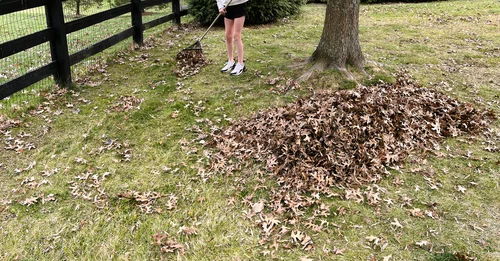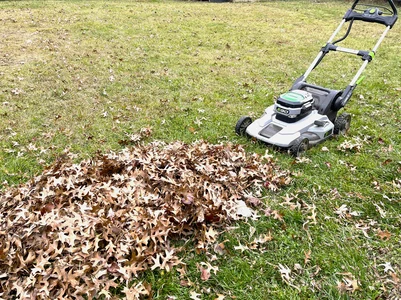
The Green Lawn Revolution: Composting Leaves with a Lawn Mower
Transforming your lawn into an eco-friendly paradise is easier than you might think. Why hassle with bagging your leaves up, when there’s an easier solution that’s great for your lawn, your back, and the environment. One of the simplest yet most effective practices involves using your trusty lawn mower to compost leaves. This method not only nurtures your lawn but also significantly benefits the environment.
Composting leaves with a lawn mower, often referred to as “mulching,” involves a straightforward process. You begin by raking leaves into a pile and then running them over with a lawn mower. This action shreds the leaves into smaller pieces, facilitating quicker decomposition. The resulting compost can then be evenly spread across the lawn, providing vital nutrients to the soil.
The Science Behind Leaf Composting
When leaves are shredded and then decomposed, they embark on a transformative journey, becoming more than just remnants of fall; they turn into a powerhouse of nutrients that rejuvenates your lawn. This natural process hinges on several key factors and beneficial outcomes. As leaves decompose, they release a rich array of nutrients, including nitrogen, phosphorus, and potassium—elements fundamental to plant growth. This is nature’s way of recycling; what falls from the trees is repurposed to nourish the earth. Nitrogen is crucial for leaf and stem growth, phosphorus for root and flower development, and potassium for overall plant health. This trio works in harmony to create a balanced diet for your lawn, fostering robust growth and green vibrancy.
Beyond mere nutrition, the process of leaf composting significantly improves the soil’s structure. As the shredded leaves break down, they integrate into the soil, increasing its organic matter content. This enhancement leads to better aeration, allowing roots to breathe and grow more freely. Improved soil structure also aids in water retention. The organic matter acts like a sponge, holding onto moisture and releasing it slowly over time. This means more water is available for your plants, and you may find yourself needing to water less frequently, a boon during dry spells.
Environmental Benefits of Leaf Composting
Reducing Landfill Waste
Landfills are the third-largest source of human-related methane emissions in the United States, accounting for approximately 14.1 percent of these emissions in 2017, as per the EPA. Methane is a potent greenhouse gas, with a global warming potential more than 25 times greater than that of carbon dioxide over a 100-year period. In landfills, organic matter like leaves decomposes anaerobically (without oxygen), releasing methane, a potent greenhouse gas. By composting leaves at home, you significantly reduce your carbon footprint.
Encouraging Biodiversity
Composting leaves on your lawn creates a habitat for a variety of organisms, from earthworms to beneficial bacteria. These organisms play a crucial role in maintaining soil health and biodiversity.
Conservation of Resources
Leaf composting with a mower eliminates the need for plastic bags used in leaf disposal, thus reducing plastic waste. Also, let’s not forget the transportation of waste to landfills consumes a substantial amount of energy and contributes to greenhouse gas emissions. For instance, diesel-fueled garbage trucks used for waste collection and transportation are significant contributors to urban air pollution.
Benefits to Your Lawn
Natural Fertilization
Composted leaves provide a rich, natural fertilizer for your lawn. They slowly release nutrients into the soil, promoting healthier, more robust grass growth.
Soil Improvement
The addition of composted leaves enhances soil structure. It improves aeration and water retention, making your lawn more drought-resistant and reducing the need for frequent watering.
Pest and Disease Control
A well-nourished lawn with balanced soil is less susceptible to pests and diseases. This natural resistance means less reliance on chemical pesticides and fungicides, making your lawn safer and more sustainable.
The Process

Step 1: Rake Leaves into Piles
Start by raking the leaves into manageable piles. This step makes it easier for the mower to run over them and ensures even composting. Do it quickly and you are getting some great exercise.
Step 2: Mow Over the Leaves

Before starting the mower, you’ll want to adjust your mower’s height to the lowest, or perhaps 2nd lowest, level before doing this so that the mower blade can make contact with most of the leaves. Then start ’er up and go right into the pile! A “Pac-Man” (or Hungry, Hungry Hippo if you are old enough to remember that) approach to working through the leaf pile tends to work well. Keep going until you can ensure the leaves are sufficiently shredded into small pieces.
Step 3: Spread the Compost
After mowing, rake out the shredded leaves evenly across your lawn. This layer of leaf compost will gradually break down and integrate into the soil. Don’t skip this step! Leaving a large pile of shredded leaves in a single spot would kill any grass underneath it. Raking it out across the lawn is the difference between a mulch that could harm the grass and a compost fertilizer that will steadily nourish your lawn.
Why This Method Triumphs Over Bagging
Eco-Friendly and Sustainable
Composting leaves with a lawn mower is a sustainable practice that aligns with principles of environmental conservation. It reduces waste, conserves resources, and supports the ecological balance in your garden.
Cost-Effective and Efficient
This method is not only environmentally friendly but also cost-effective. It eliminates the expense of buying fertilizers and saves time and effort involved in bagging and disposing of leaves.
Promotes a Healthier Lawn
The natural composting process fosters a healthier, more vibrant lawn. It enriches the soil, supports grass growth, and creates a lush, green outdoor space.
Conclusion
I’ve used this method for years, but wish I had discovered it sooner. Composting leaves with a lawn mower is a simple yet impactful way to contribute to environmental sustainability. It transforms a routine lawn care task into an eco-friendly practice, enhancing the health of your lawn while reducing your ecological footprint. Embracing this method is a step towards a greener, more sustainable future, right in your backyard.

